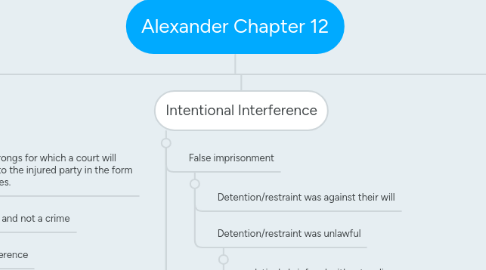
1. Tort
1.1. Variety of civil wrongs for which a court will afford a remedy to the injured party in the form of money damages.
1.2. Person to person and not a crime
1.3. Intentional interference
1.4. Strict Liability
1.5. Negligence
1.6. Save Harmless Law
1.6.1. School covers employees up to policy amount
1.7. Educational malpractice
1.7.1. Not allowing a student to get an education
1.8. Constitutional torts
1.8.1. Violation of statue or constitutional rights
2. Intentional Interference
2.1. False imprisonment
2.1.1. Detention/restraint was against their will
2.1.2. Detention/restraint was unlawful
2.1.2.1. relatively brief and without malice
2.2. Defendant voluntarily invades interests of another
2.2.1. Assault and battery
2.3. Standard of conduct
2.3.1. Exposing another to "unreasonable risks"
2.3.2. Reasonable person test
2.3.2.1. hypothetical from a community ideal of human behavior, whose conduct under the same or similar circumstances is regarded as the measure of reasonable behavior
2.4. Reasonably prudent teacher
2.4.1. Teacher stands in place of the parents
3. Strict liability
3.1. Very rare
3.2. unreasonably dangerous defective products/ultra-hazardous activities
4. Negligence
4.1. Conduct falling below a legally established standard which results in the injury to another person
4.2. Elements of negligence
4.2.1. Duty
4.2.1.1. duty owed by one person to another intensifies as the risk increases
4.2.2. Standard of care
4.2.2.1. teacher owes a student extra duty to keep the children secure from injury
4.2.3. Proximate or legal cause
4.2.3.1. Actions of the defendant caused injury to another
4.2.4. Injury or actual loss
4.2.4.1. Defendant must be liable and plaintiff must show damages.
5. Defense for negligence
5.1. Accident vs negligence
5.2. duty was not owed or intervening act broke the chain between act and injury
5.3. Contributory Negligence
5.3.1. Injured party has fault for causing injury
5.4. Comparative negligence
5.4.1. Negligence can be split among multiple parties based on percentage (even injured party)
5.5. Assumption of Risk
5.5.1. The plaintiff expressed or implied agreement assumes the risk of danger and relives the defendant of responsibility
5.6. Exculpatory Notes
5.6.1. Release forms that parents sign giving students permission to do activity
5.7. Act of God
5.7.1. Random or unforeseen natural element
